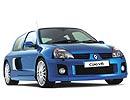-

blind3k - Stalni uporabnik
- Prispevkov: 584
- Pridružen: Ne avg 19, 2007 11:27 pm
- Kraj: Ljutomer,Koper
-

Joie de vivre! - Moderator foruma
- Prispevkov: 4258
- Pridružen: Če feb 10, 2005 12:25 pm
- Kraj: Gorenja vas
-

avtomobil - Novinec
- Prispevkov: 287
- Pridružen: Če apr 28, 2005 8:40 am
-

martin_krpan - Mojster foruma
- Prispevkov: 11222
- Pridružen: Sr feb 22, 2006 8:26 pm
- Kraj: Ribnica
Članek v NY Times:
http://www.nytimes.com/2008/01/08/busin ... ref=slogin

http://www.nytimes.com/2008/01/08/busin ... ref=slogin
For Tata Motors of India, which will introduce its ultra-cheap car on Thursday, the better question was, what could it take out?
The company has kept its new vehicle under wraps, but interviews with suppliers and others involved in its construction reveal some of its cost-cutting engineering secrets — including a hollowed out steering-wheel shaft, a trunk with space for a briefcase and a rear-mounted engine not much more powerful than a high-end riding mower.
The upside is a car expected to retail for as little as the equivalent of $2,500, or about the price of the optional DVD player on the Lexus LX 470 sport utility vehicle.
The downside is a car that would most likely fail emission and safety standards on any Western road, and, perhaps, in India in a few years, when the country imposes tougher environmental standards.
But Tata is not looking to ply California’s highways. Instead, the company wants to provide four-wheel transportation for the first time to people accustomed to getting around on two, including hundreds of millions of Indians and others in the developing world.
Even so, the “People’s Car” (a nickname, since Tata has kept the real name under wraps, too) may ultimately affect what many people drive around the world, since it is part of a broader trend among carmakers to try to build less expensive cars.
“It’s basically throwing out everything the auto industry had thought about cost structures in the past and taking out a clean sheet of paper and asking, ‘What’s possible?’” said Daryl T. Rolley, head of North American and Asian operations for Ariba, which helps supply parts to Tata, BMW, Toyota and other carmakers. “In the next five to 10 years, the whole auto industry is going to be flipped upside down.”
The French-Japanese alliance Renault-Nissan and the Indian-Japanese joint venture Maruti Suzuki are trying to figure out how to make ultra-cheap cars for India. And struggling Western automakers are looking to see where the cost-obsessed ethos of the developing world can help their bottom line. In the most recent example, Ford was expected to announce Tuesday that it would make India its manufacturing hub for low-cost cars.
Some analysts are predicting that just as the Japanese popularized kanban (just in time) and kaizen (continuous improvement), Indians could export a kind of “Gandhian engineering,” combining irreverence for conventional ways of thinking with a frugality born of scarcity. Or, as Indian auto executive Ashok K. Taneja describes the philosophy, “When I need silver, why am I investing in gold?”
Some of the few people who have seen the car describe a tiny, charming, four-door, five-seater hatchback shaped like a jelly bean, small in the front and broad in the back, the better to reduce wind resistance and permit a cheaper engine. “It’s a nice car — cute,” said A. K. Chaturvedi, senior vice president of business development at Lumax Industries, a supplier in Delhi that developed the car’s headlights and interior lamps.
Driving the cost-cutting were Tata’s engineers, who in an earlier project questioned whether their trucks really needed all four brake pads or could make do with three. As they built Tata’s new car, for about half the price of the next-cheapest Indian alternative, their guiding philosophy was: Do we really need that?
The model appearing on Thursday has no radio, no power steering, no power windows, no air-conditioning and one windshield wiper instead of two, according to suppliers and Tata’s own statements. Bucking prevailing habits, the car lacks a tachometer and uses an analog rather than digital speedometer, according to Mr. Taneja, who until recently was president of the Automotive Component Manufacturers Association of India, representing many of Tata’s suppliers as they signed deals with the company.
Frugal engineering pervades the car’s internal machinery, too, with even greater implications for the vehicle’s safety and longevity.
To save $10, Tata engineers redesigned the suspension to eliminate actuators in the headlights, the levelers that adjust the angle of the beam depending on how the car is loaded, according to Mr. Chaturvedi of Lumax. In lieu of the solid steel beam that typically connects steering wheels to axles, one supplier, Sona Koyo Steering Systems, used a hollow tube, said Kiran Deshmukh, the chief operating officer of the company, which is based in Delhi.
Tata chose wheel bearings that are strong enough to drive the car up to 45 miles an hour, but they will wear quickly above that speed, reducing the car’s life span but not threatening consumer safety, according to Mr. Taneja. The car’s top speed is 75 miles an hour.
Reducing the weight curbed material costs and enabled the company to use a cheaper engine. People familiar with the car describe a $700 rear-mounted engine built by the German company Bosch, measuring 600 to 660 cubic centimeters, with a horsepower in the range of 30 to 35. By comparison, the Honda Fit, one of the smallest cars available in the United States, has a horsepower of 109.
According to industry experts, the car runs on a continuous variable transmission, a lighter alternative to manual or automatic transmissions.
Though it was never popular in the United States because of its often sluggish acceleration, continuous transmission was once widespread in Europe and has resurfaced in the United States in vehicles like the Nissan Murano S.U.V. and the Toyota Prius.
While Tata reverted to old technologies in places — Leonardo da Vinci conceived an elegant precursor to the continuous transmission in the 15th century — it embraced cutting-edge sourcing practices, said Mr. Rolley at Ariba, which has assisted both Tata and its foreign rivals in buying parts.
Skip to next paragraph
Multimedia
Tata Motors’ $2,500 CarGraphic
Tata Motors’ $2,500 Car
Related
Ford to Expand in India, Planning a Small Car and an Engine Plant (January 8, 2008)
Managing Globalization Blog
Managing Globalization Blog
A New Price Point for Carmakers
Go to Blog »
Readers' Comments
"Sign me up!! I will get one in each color!"
Romulo, The Sonoran Desert
* Read Full Comment »
Traditionally, carmakers cultivated long-term relationships with suppliers, but companies have gradually embraced electronic sourcing, using Internet auctions that force suppliers to compete for business. But even the most efficient carmakers buy no more than 10 percent to 15 percent of parts electronically, Mr. Rolley said. Tata sources 30 percent to 40 percent that way.
Critics of the Tata car have asked how a car that prunes thousands of dollars off regular prices can possibly comply with safety and environmental norms. The answer may be that the car comes at a particular moment in India’s development, when the country is affluent enough to support strong demand for automobiles but still less regulated than developed countries.
Tata officials say the car will comply with all Indian norms. But they are changing. India’s major cities plan to adopt the Euro IV emissions standard in April 2010, requiring a 35-fold reduction in sulfur emissions over the current Euro III standard, according to Anumita Roychowdhury of the Center for Science and Environment in New Delhi.
New safety rules mandating air bags, antilock brakes and full-body crash tests are also coming, Ms. Roychowdhury said.
She said it was unlikely the car would be able to keep its populist price tag once those regulations take effect.
And the car may be less environmentally friendly than it claims. Unlike cars in the United States, Indian vehicles do not have to come in for regular inspections after they are on real roads, which often batter the systems that curb emissions.
Michael Walsh, a pollution consultant and former United States Environmental Protection Agency regulator, said that a car so cheap was likely to lack the complex technology to maintain its initial level of emissions and that without such technology cars could soon be producing four to five times their initial pollution level.
“It strikes me as impossible that such a vehicle will be a very clean vehicle over the life of the vehicle,” Mr. Walsh said.
In a recent interview, Ratan Tata, chairman of the Tata Group, also suggested that the car’s lightness, while favorable for the environment, had frustrated efforts to make it safe. “We will have far lower emissions than today’s low-end cars,” he said. But, he added, “the emissions standards were much easier to meet than the crash test.”
In most American cars, safety features alone cost more than $2,500, said Adrian Lund, president of the Insurance Institute for Highway Safety in Arlington, Va. But, he added, “if what we’re talking about in India is people having the option of getting off the streets, from motorcycles and bicycles where they are at risk from bigger vehicles, this may actually be an improvement of the safety environment.”
Even if the Tata car never drives on Western roads, the philosophy behind it will influence global car makers, Mr. Rolley of Ariba said.
Manufacturers are searching for ways to make small cars for the middle class in India and China; to produce small cars for their own markets, hurt by rising gas prices; and to improve the profit of existing larger cars. Tata’s car would be mined for applicable lessons, Mr. Rolley said, predicting that more would be designed with cost in mind.
In one past example, after Renault-Nissan began making cheap cars in Romania, it transferred low-cost engineering techniques to its plants producing more expensive models — for example, making doors flatter so they could be stacked in greater volume in shipping containers, according to Pauline Kee, a Nissan spokeswoman.
Consumers in wealthy nations can perhaps expect more hollow steering shafts, actuator-free headlights and tiny trunks.
“This will be no different,” Mr. Rolley said, “from when U.S. companies spent a whole decade in the ’80s thinking about what Japanese management techniques they had to adopt.”

Kobilica:
http://www.avtomobilizem.com/forum/viewtopic.php?f=7&t=88076&start=0
http://www.avtomobilizem.com/forum/viewtopic.php?f=7&t=88076&start=0
-

esem - Moderator foruma
- Prispevkov: 9988
- Pridružen: Ne mar 27, 2005 6:35 am
- Kraj: Ljubljana pri Kozarjah
V citatu iz NY Times-a piše med drugim tudi to:
Edina nevarno šibka točka projekta glede na izkušnje z zanesljivostjo Boschevih sklopov (v Fiatih, PSA, MB, BMW itd)? :P
People familiar with the car describe a $700 rear-mounted engine built by the German company Bosch, measuring 600 to 660 cubic centimeters, with a horsepower in the range of 30 to 35.
Edina nevarno šibka točka projekta glede na izkušnje z zanesljivostjo Boschevih sklopov (v Fiatih, PSA, MB, BMW itd)? :P
- dms
- Novinec
- Prispevkov: 433
- Pridružen: So apr 21, 2007 5:59 pm
avtomobil je napisal/-a:Mislim, da tudi v SLO tak avto ne more doseči neke take prodaje, da bi se avtomobil splačalo uvažati.
Tak avto pride v poštev v manj in nerazvitem svetu.
Nevem zakaj se ga nebi splacalo uvazat.Mene pac spominja na mali mestni avto,s 5 vrati.Zanesljivost je vprasljiva?Zakaj,zakaj bi bil pa naprimer BMW ali pa Renault toliko bolj zanesljiv?Dejte ga srat.Edino kar je res vprasljivo pri tem avtocku je servisna mreza,ki nevem kako je po Evropi vzpostavljena.Drgac je pa za ta dnar cist dobr.Jest mu pa napovedujem svetlo prihodnost.Avto za siroke mnozice,ki so seveda brez otrok.Ali pa kot drugi avto.Za po mestu.Indijski smart.
-

adis - Uporabnik
- Prispevkov: 8095
- Pridružen: To jan 30, 2007 1:47 pm
- Kraj: Ljubljana
- dms
- Novinec
- Prispevkov: 433
- Pridružen: So apr 21, 2007 5:59 pm
-

MacTron - Administrator a.com
- Prispevkov: 8424
- Pridružen: To sep 10, 2002 9:55 pm
- Kraj: Dezela Kranjska
-

avtomobil - Novinec
- Prispevkov: 287
- Pridružen: Če apr 28, 2005 8:40 am
Ja, ena od možnosti tegale indijskega smarta je, ta, da za EU trg naredijo avto z več dodatne opreme. Samo sedaj je vprašanje koliko bi mu cena narasla (če prištejemo še carino in ostale stroške) glede na konkurenco kot je Twingo ali pa Spark. Sicer pa če bi tale indijski smart imel tudi klimo bi potreboval močnejši motor.
Avto,moj partner!!!!!!!!
-

sebaveh - Poznavalec foruma
- Prispevkov: 2334
- Pridružen: Po mar 28, 2005 8:50 am
- Kraj: Slov. Bistrica
esem je napisal/-a:V citatu iz NY Times-a piše med drugim tudi to:People familiar with the car describe a $700 rear-mounted engine built by the German company Bosch, measuring 600 to 660 cubic centimeters, with a horsepower in the range of 30 to 35.
Edina nevarno šibka točka projekta glede na izkušnje z zanesljivostjo Boschevih sklopov (v Fiatih, PSA, MB, BMW itd)? :P
Še vedno bolje Bosch, kot pa Dark Lord Lucas
Najbolj smešno pa mi je tisto o mehanizmu za luči, da so le prišparali magičnih 10 $
EDD: Now what?
EDDY: I'm thinking, I'm thinking...
ED: Can I think?
EDD/EDDY: NO!
EDDY: I'm thinking, I'm thinking...
ED: Can I think?
EDD/EDDY: NO!
-

tha_man - Uporabnik
- Prispevkov: 1008
- Pridružen: To nov 08, 2005 7:18 pm
Po specifikacijah in slikah zgleda odlična alternativa tamalemu smartu, C1/Aygo/P107 in podobnim ekstra majhnim in ekstra DRAGIM (za njihovo velikost) avtomobilom. Kot mestni avto ima več kot zadovoljive performance, pa tud za par sto kilometrov okrog mesta ne bi smel bit problematičen.
Z rabljenimi ga je pa brezveze primerjat. Rabljena je rabljen, nov je nov.
Z rabljenimi ga je pa brezveze primerjat. Rabljena je rabljen, nov je nov.
-

esem - Moderator foruma
- Prispevkov: 9988
- Pridružen: Ne mar 27, 2005 6:35 am
- Kraj: Ljubljana pri Kozarjah
Dve novici
Pri karoseriji bodo sodelovali s Caparo-m, v Evropo pride leta 2012 in to prenovljen model, ki bo ustrezal euro 5 in varnostnim normam, porabo pa bodo znižali na 3 (!!) litre.
27 slik http://www.autobloggreen.com/photos/tat ... oples-car/
O sodelovanju s Caparom še tu http://www.hindu.com/2008/02/09/stories ... 971500.htm

Pri karoseriji bodo sodelovali s Caparo-m, v Evropo pride leta 2012 in to prenovljen model, ki bo ustrezal euro 5 in varnostnim normam, porabo pa bodo znižali na 3 (!!) litre.
27 slik http://www.autobloggreen.com/photos/tat ... oples-car/
Tata Nano body will be built by Caparo Group, car coming to Europe in 2012
Two updates on the Tata Nano, aka the world's cheapest car.
Posted Feb 11th 2008 1:04PM by Sebastian Blanco
First, the Indian minicar will have its body structure built by the Caparo Group at a plant in Singur that is next to the manufacturing plant that will build the Nano. Caparo will make 60 percent of the assemblies, and Tata will take care of the rest. The contract was finalized Friday and production will start in six months, an awfully quick turnaround.
Second, Reuters is reporting that the Nano will be coming to European market in four years. That model will be an updated version that "will meet the Euro 5 emission regulations and the crash standards in Europe," Girish Wagh, the head of Tata's compact car business to the German magazine Focus. One incredible upgrade: reducing gasoline usage from the current five liters per 100 km (47 mpg U.S.) to three (78 mpg).
O sodelovanju s Caparom še tu http://www.hindu.com/2008/02/09/stories ... 971500.htm
Caparo, manufacturer of the world’s highest performance road-capable hyper car, the Caparo T1, will supply 60 per cent of the assemblies, with the balance being manufactured in-house by the Tatas, according to a press release issued by Caparo.
Caparo has installed a new semi-automated production line with zero fault forward quality control systems to meet the Tatas’ ambitious cost targets.
“The body technology is relatively conventional, but the manufacturing technology is the result of sophisticated analysis to ensure high-quality, low cost production,” said Caparo Group CEO Angad Paul in a press statement released on Friday. “We completed this quickly to meet our customer’s deadline, with start of production just six months after the contract was confirmed.”
The Tatas chose Caparo for this substantial contract because of the firm’s success with a similar contract to supply the Suzuki Maruti 800, and for its reputation for high quality.
“We have been delivering to plants in India at zero ppm (parts per million) for three years,” Caparo India country head Sunil Pahilajani said.
Caparo also supplies Indian plants for Ashok Leyland, Eicher Motors, JCB, John Deere and Hero Honda, as well as most manufacturers of two and three wheeled vehicles.

- Dr.M3
- Uporabnik
- Prispevkov: 1409
- Pridružen: Sr dec 19, 2007 12:28 pm
-

R 26 - Stalni uporabnik
- Prispevkov: 631
- Pridružen: To maj 15, 2007 1:27 pm
- Kraj: dolenjska je moja mati
-

berlonso - Uporabnik
- Prispevkov: 1155
- Pridružen: Po nov 05, 2007 9:18 pm
-

Joie de vivre! - Moderator foruma
- Prispevkov: 4258
- Pridružen: Če feb 10, 2005 12:25 pm
- Kraj: Gorenja vas
-

alesdrolec - Uporabnik
- Prispevkov: 841
- Pridružen: Pe maj 18, 2007 6:17 am
- Kraj: Kamnik
-

E=mc^2 - Novinec
- Prispevkov: 278
- Pridružen: To maj 17, 2005 6:52 pm
-

kljukec - Mojster foruma
- Prispevkov: 3380
- Pridružen: To jan 04, 2005 10:50 pm
- Kraj: Ljubljana
Kdo je prisoten
Po forumu brska: 0 registriranih uporabnikov in 15 gostov



